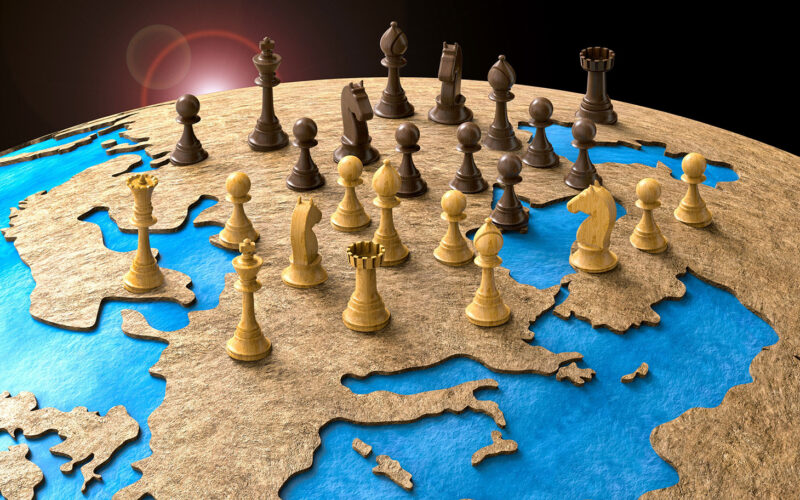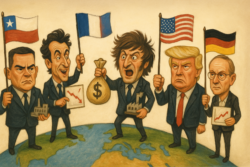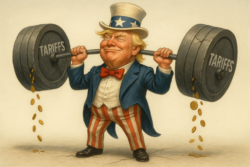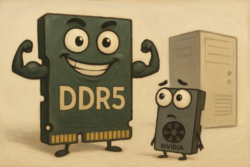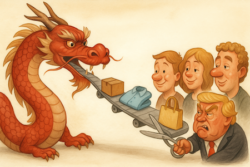Publisher’s Note: We love tech stocks. But there’s a time and a place for them. Arguably, right now isn’t that time – not as a large percentage of your portfolio anyway.
Instead, as Jim Rickards explains below, if you’re starting a portfolio or you’re look for a place to allocate spare cash, there are better options. Read below for more (for what it’s worth, we agree 100% with Jim’s take on this)…
In the 1920s, Radio Corporation of America (RCA) was the hottest stock in the world.
Radio was cutting-edge tech, and RCA was dominant in the sector. The company was the largest manufacturer of radio sets and operated the largest broadcasting company, NBC. They owned key patents and had attracted many of the country’s best engineers.
In 1921 RCA shares traded as low as $1.50 (split-adjusted). By 1929 RCA rose to a peak of $549. A 352x return.
At its highs in 1929 RCA was trading at a P/E of 72x. Speculation had driven the price far beyond rational levels.
The bubble popped in 1929, and by 1932 RCA shares were trading at $15. That’s still a 10x return over 11 years, but the majority of investors had bought in at much higher prices. The use of margin borrowing was commonplace, and added fuel to the fire (sound familiar?).
Of course, we also saw a similar mania during the dot-com bubble. Cisco, Intel, and a few other tech leaders soared to unimaginable heights, then crashed back down to Earth.
You could say RCA was the Cisco of the Roaring ‘20s. And possibly the Nvidia of its time.
Is DeepSeek the Pin?
China’s new AI model DeepSeek R1 has the potential to be the pin that pricks the AI bubble. But it hasn’t happened yet.
In January, Nvidia shares fell 17% after the market had digested China’s AI developments.
But shares rebounded quickly by almost 9%. The dip was bought, for now at least.
I don’t know if this Chinese AI model will be the catalyst that ends the AI mania. But the bubble will inevitably end.
The market is poised for a crash, it only requires the right catalyst. Something frightening. A bank run, financial crisis, war, or even an AI breakthrough from our primary competitor.
Whether this latest Chinese AI model is that catalyst remains to be seen. But the 17% one-day drop in Nvidia shares does demonstrate that this market is easily spooked.
Profits (and Risks) Concentrated
The rise of AI in America has severely concentrated market risk. Even before the AI boom, markets were already heavily tilted towards big tech.
Today it’s far more pronounced. Anyone investing in the S&P 500 has more money in the Mag 7 stocks than they do in the bottom 400 companies put together. These 7 big tech firms make up about 34% of the entire S&P 500.
This is what happens during bubbles. A handful of companies dominate the market.
Make no mistake, these periods are driven by real advances. But they inevitably get out of control. It has happened with every major technological development. Railroads, internet, crypto, and now AI.
Anyone who has studied manias can clearly recognize the signs. Problem is, it’s difficult to know exactly when it will end. But judging by the market’s recent action, we’re getting closer.
Go Analog to Hedge Digital
If you own almost any American stock market index, you likely have plenty of exposure to Nvidia, Microsoft, Google, Amazon and the rest of the Magnificent 7.
Now is not a time to jump into these names as the tech sector remains vulnerable. I much prefer to buy areas the rest of the market is ignoring. Gold, silver, miners, oil and gas, residential real estate. Hard assets.
Despite all the hype around this tech cycle, we are still entering a hazardous monetary period. The U.S. and much of the world have entered into debt spiral territory. Once debt/GDP broaches 120%, as it did recently in the U.S., it almost always leads to a debt or monetary crisis. Even in a best case it leads to a prolonged period of slow growth, which is also poison for stocks.
AI is powerful, but it cannot save us from mathematics. So if you don’t have any, go buy some hard assets. The easiest place to start is gold and silver coins. I suggest that everyone should have 10% of their portfolio in these assets. They remain the ultimate diversifiers.
Best,

Jim Rickards
Contributing Editor, Investor’s Daily
P.S. I’ve seen enough bubbles in my career to know how this ends. AI is transformative—but it can’t stop the forces already set in motion by decades of debt, monetary distortion, and now, global realignment. That’s why I created what I call American Birthright. It’s my complete blueprint that aims to protect your wealth — and help position yourself for what I believe will be one of the greatest financial shifts of our lifetime. I urge you to take a look while there’s still time.
Conspiracy of Dunces
Bill Bonner, from the ranch at Gualfin, Argentina

The Cemetery at Gualfin
“The first time, I had two things to do — run the country and survive; I had all these crooked guys,” Trump said in an interview with the Atlantic. “And the second time, I run the country and the world.”
Trump is the Big Man. He believes his writ should be law and that wind and waves — at home and abroad — should bow to his will. His fans believe it too. They didn’t vote for 50% tariffs. Or for deporting infant citizens. They voted for Trump — Pompey, Caesar, and Augustus all in one…the man…and they trust him to do what needs to be done, whatever it may be.
There is nothing really unusual about this. The Greeks noticed thousands of years ago that democracy tended to become less consensual and more dictatorial as time went by. The Big Man offered simplification, retribution and justice. He didn’t necessarily come with a coherent program, but he promised to smite the common man’s enemies. And that was enough.
And despite all the wailing and whining in the mainstream press, there’s nothing to say that the change from collaborative democracy to Big Man rule represents a degradation in the quality of government. When things need doing, the Big Man is able to do them. He is less restrained by rules and institutions, which by this time have become mostly parasitic and self-serving anyway.
All political arrangements, being part of life itself, decay over time. Constitutions are re-interpreted. Public mores become more elastic. Bread and circuses tend to replace modest, restrained leadership.
All empires rise and fall, with an average life-span only slightly longer than a Bowhead whale. America’s empire – judged from when it took over the Philippines after a jingoed-up war with Spain — is already more than halfway there. Arguably, it has been in decline for a quarter of a century. And what it needs now — from this historical perspective — is a leader who will continue the downward trend. Mr. Trump may be that man.
But no one runs a government alone. Even Louis 14th — an ‘absolute monarch’ — relied on legions of soldiers, tax collectors, informants, sycophants, suck-ups and public servants. And as Elon Musk put it on X (correctly, but perhaps unwisely): “Hitler didn’t murder millions of people; public sector employees did.”
A wise and powerful ruler can prevent mass murder. Or cause it. He can even halt, at least temporarily, the decline of an empire. But in that, too, he needs supporters, lackeys, fixers, and fans.
On Monday, we looked at how easy it would be. There are really two key threats to the US empire. They are the traditional ones — money and military. Typically, the money runs out and the military runs wild.
We looked at how both problems could be easily solved — in theory.
But there is more to the story; there are the connivers, the professional patriots and casual traitors. For example, there is no reason to spend $1 trillion per year on the Pentagon. Except that, those public sector employees — conspiring with the firepower industry — want to see the money keep coming… all the way to bankruptcy. Open Secrets:
Defense companies spend millions every year lobbying politicians and donating to their campaigns. In the past two decades [to 2021], their extensive network of lobbyists and donors have directed $285 million in campaign contributions and $2.5 billion in lobbying spending to influence defense policy. To further these goals they hired more than 200 lobbyists who have worked in the same government that regulates and decides funding for the industry.
The chance of an invasion of the US is approximately zero. No country has a fleet that could support a sea-borne assault. No country has an economy that could support such a fleet. No country could develop such a fleet, unobserved. And if by some miracle the means were found…and the will to waste trillions of dollars somehow took hold of an enemy nation…the poor invading force would be obliterated long before it reached the middle of the vast ocean.
The only real threat comes from the air, where America’s ‘Triad’ defense — land-based missiles, submarines, and long-range bombers — is more than enough to meet the challenge. That Triad, by the way, requires few soldiers…and no foreign bases. Its cost is very modest, a fraction of the ‘defense’ budget. The rest of the ‘defense’ budget is not meant for defense at all… but just for projecting US imperial power and directing hundreds of billions to America’s firepower industry.
The idea of a ‘conspiracy’ is that people get together to achieve some underhanded purpose. For example, there are people — apparently sane, apparently sensible — who believe Donald Trump is actually an asset of the Russian government. They say he was recruited as early as 1987 and to everyone’s surprise ended up as president. Business Insider:
The KGB cultivated Donald Trump as an asset for 40 years, and he proved a highly valuable asset in repeating anti-Western Russian propaganda in the United States, a former KGB operative told The Guardian.
As shocking as it might be, it doesn’t matter. Mr. Trump could perfectly well come to his positions on his own. Biden favored Zelensky. Trump favors Putin. So what? Conspiracy or not, the conflict is none of our business…and no threat to the empire.
Likewise, the slaughter in Gaza may be of concern on moral grounds… or ideological grounds. It may be called a ‘conspiracy’ too, in which both Republicans and Democrats are in effect paid ‘assets’ for a foreign cause. The Intercept:
AIPAC (America, Israel Public Affairs Committee)…funded Republican, Democrat, and independent candidates alike. AIPAC [in 2024] supported 233 Republicans with a total of more than $17 million in funds, 152 Democrats who received more than $28 million…
Mayhem in the Near East may be a distraction and an unnecessary expense, but as far as the ‘defense’ of the US is concerned, it just doesn’t matter.
The conspiracy that really matters is the obvious one. Home-grown politicians, the Pentagon/Intelligence Establishment and the firepower industry — all conspire against the public interest for their own gain..
And unwittingly drag the empire to the graveyard.
Regards,

Bill Bonner
Contributing Editor, Investor’s Daily
For more from Bill Bonner, visit www.bonnerprivateresearch.com
